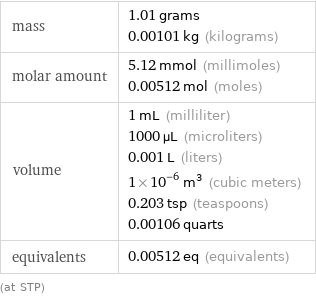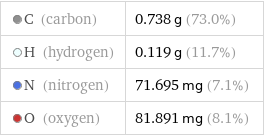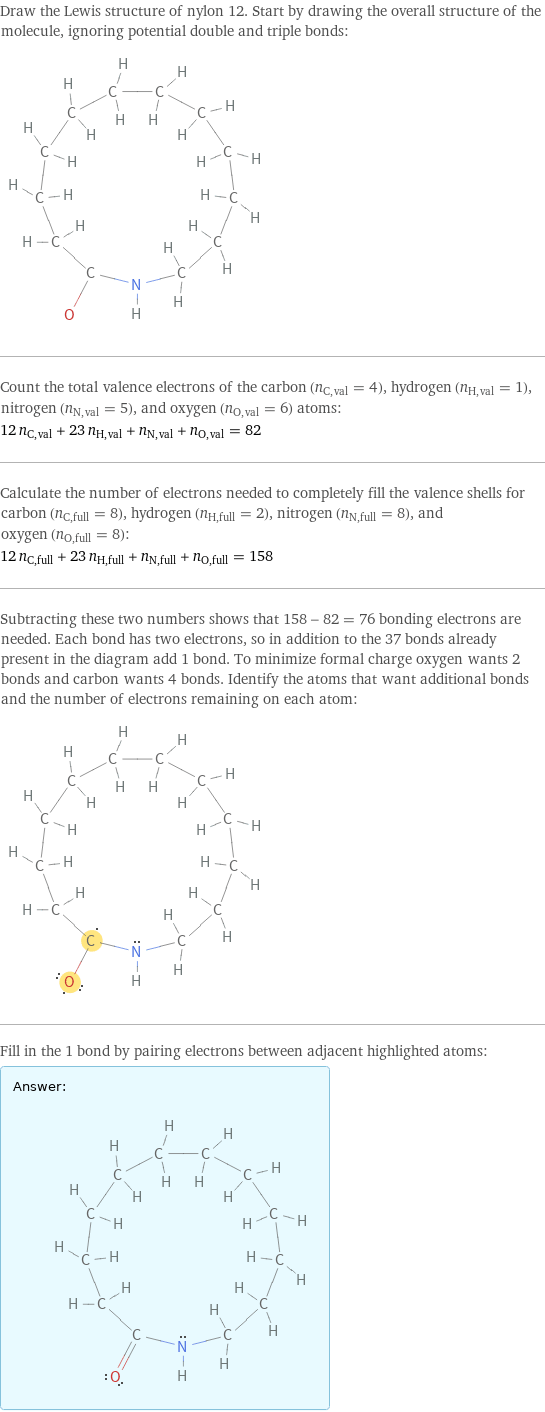Input interpretation

1 cm^3 of nylon 12
Basic properties for 1 cm^3

mass | 1.01 grams 0.00101 kg (kilograms) molar amount | 5.12 mmol (millimoles) 0.00512 mol (moles) volume | 1 mL (milliliter) 1000 µL (microliters) 0.001 L (liters) 1×10^-6 m^3 (cubic meters) 0.203 tsp (teaspoons) 0.00106 quarts equivalents | 0.00512 eq (equivalents) (at STP)
Corresponding quantities

sphere radius | 6.204 mm (millimeters) side of a cube | 10 mm (millimeters)
Mass composition for 1 cm^3

C (carbon) | 0.738 g (73.0%) H (hydrogen) | 0.119 g (11.7%) N (nitrogen) | 71.695 mg (7.1%) O (oxygen) | 81.891 mg (8.1%)

Mass composition for 1 cm^3
Lewis structure

Draw the Lewis structure of nylon 12. Start by drawing the overall structure of the molecule, ignoring potential double and triple bonds: Count the total valence electrons of the carbon (n_C, val = 4), hydrogen (n_H, val = 1), nitrogen (n_N, val = 5), and oxygen (n_O, val = 6) atoms: 12 n_C, val + 23 n_H, val + n_N, val + n_O, val = 82 Calculate the number of electrons needed to completely fill the valence shells for carbon (n_C, full = 8), hydrogen (n_H, full = 2), nitrogen (n_N, full = 8), and oxygen (n_O, full = 8): 12 n_C, full + 23 n_H, full + n_N, full + n_O, full = 158 Subtracting these two numbers shows that 158 - 82 = 76 bonding electrons are needed. Each bond has two electrons, so in addition to the 37 bonds already present in the diagram add 1 bond. To minimize formal charge oxygen wants 2 bonds and carbon wants 4 bonds. Identify the atoms that want additional bonds and the number of electrons remaining on each atom: Fill in the 1 bond by pairing electrons between adjacent highlighted atoms: Answer: | |
Chemical names and formulas

formula | (C_12H_23NO)_n Hill formula | C_12H_23NO name | nylon 12 IUPAC name | 1-azacyclotridecan-2-one
Substance properties

molar mass | 197.32 g/mol density | 1.01 g/cm^3
Units
